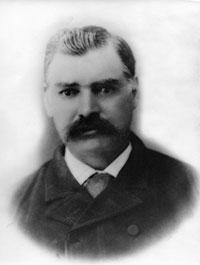

The son of Richard T. Booth and Elsie Edge was born in Lancashire, England on June 29, 1847. His father was a teacher until he lost his job because he joined the Mormon church. In 1857, Mr. and Mrs. Booth, with their ten-year old son John and three other children, crossed the Atlantic to join other Mormons. Soon after arriving in Salt Lake City, the family fled because of an invading U.S. Army. In 1858, they settled in Alpine, northeast of American Fork. It was there that Richard Booth became a respected teacher, superintendent of the cooperative store, justice of the peace, and high priest in the LDS church. 1
When John was 13 years old, he herded sheep in Draper, Salt Lake County. As a volunteer in the 1866 Blackhawk War, Booth served on the Sevier River. His education included classes at Draper Academy in 1868 and the University of Deseret, now the University of Utah. He taught school in Alpine, West Jordan, and at Mill Creek Ward School, and Bountiful High School. 2
Like other young men of that era who wanted legal training, Booth studied law in an apprenticeship system. In his case, he studied in his spare time with John B. Billner of Provo. In 1875, Booth was admitted to the Bar of the First Judicial District, beginning a distinguished law career. His private practice included partnerships with George M. Brown from 1876 to 1887 and L.A. and E.A. Wilson for four years beginning in 1887. Clients were accepted if they were not able to pay. Booth taught law and civil government as a volunteer at the Brigham Young Academy for 30 years. Karl G. Maeser appointed Booth to be the chairman of the Mathematics Department in the new Brigham Young Academy, a good indicator of Booth's interdisciplinary abilities.
While maintaining a private law practice and teaching at the Brigham Young Academy, Booth also was the city attorney and county attorney. From 1876 to 1882 he was a city councilman or city alderman. 3 In 1877 he was instrumental in revising local ordinances. In 1881, 1889, and 1893 Booth was elected to the Territorial Legislature. 4
Booth served as Provo's mayor in 1890 and 1891. In the campaign against his rival George Sutherland, a heckler asked how Booth expected to be mayor while living in a small adobe house. Booth's humorous answer, which essentially ignored the question, helped him to gain popularity and win the election. One of the most important developments of his administration was the December 15, 1890 ordinance creating the Provo City Fire Department. 5
In May 1899 Booth was appointed judge of the Fourth Judicial District, to complete the unexpired term of Judge Warren H. Dusenberry. The next year he was appointed by Governor Thomas to the State Board of Equalization, but resigned when he was elected to continue as judge in the Fourth Judicial District.
Business ventures also took the time of Booth. He was president of Western Union and Blue Cliff Canal Company, vice president of Provo Building and Loan and also Taylor Paper Company, and director of the Provo Woolen Mills, First National Bank of Provo, the Provo Cooperative Mercantile Institution, and the Provo Lumber and Building Company. 6
For many years Booth was a local leader of The Church of Jesus Christ of Latter-day Saints. In 1875 or 1876 he became a counselor to Bishop Harvey H. Cluff of the Provo Fourth Ward. From 1877 or 1878 to 1895 he served as bishop of that ward. Twice Booth was in the presidency of the Northern States Mission first in 1883, then again in 1889. In July 1900 he was chosen the president of Utah Stake's High Priest Quorum. 7
On October 1, 1873 Booth married Maria J. Harvey, the daughter of Lewis and Lucinda Harvey. She passed away in 1884, leaving four children: Josephine, Vienna, Rowena, and Richard. In 1876 he married Hannah Billings, who died in 1881 leaving no children. Booth and his third wife Delia I. Winters had four children: James, Deliah, Elsie, and Edwin. In Provo the Booth family lived at 59 West 500 North in a house included in a walking tour produced by a former city councilman. 8
Most of this sketch comes verbatim from David M. Walden, Biographical Sketches of Former Mayors of Provo, Utah: A Report to the Provo Municipal Government, October 1, 1990, 35-38.
1 "Portrait" (1902). Portrait: A Genealogical and Biographical Record of the State of Utah. Chicago, IL: National Historical Record Company.
2 Adams, Elsie Delia (compiler), (1962). John Edge Booth, 1847-1920. Springville, UT: Art City Publishing; Bitton, Davis (1977). Summary. In Guide to Mormon Diaries and Autobiographies. Provo, UT: Brigham Young University Press.
3 "Historical Data" (1989). In Provo City Ordinances (pp. 296-298).
4 Portrait, p. 296-298.
5 Garrity, Anton (1900, 8 July). Provo Fire Department Marks Centennial. Daily Herald, pp. E1; "Historical Data"; Pardoe, pp. 7-10.
6 Portrait, 296-298.
7 Portrait, 296-298; Pardoe, 7-10. Both these sources place Booth in the presidency of the Northern States Mission in the 1880s, but that seems to conflict with the dates when was bishop of the Provo Fourth Ward.
8 Portrait, 296-298; Pardoe, 7-10. Both these sources place Booth in the presidency of the Northern States Mission in the 1880s, but that seems to conflict with the dates when was bishop of the Provo Fourth Ward.